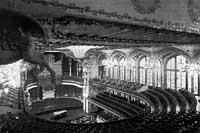Some curiosities of sound
Sounds in theaters
As everyone who has attended theatres or music concerts knows well, while some rooms are acoustically good, others are very deficient. Sometimes the voices of the singers and the sounds of the instruments are heard at a distance and sometimes they are not clearly distinguished from them. The reason for this phenomenon was explained by the prestigious physicist Wood in his book The sound waves and their use.
“Any noise made in a room has just emitted the source launchers and continues to listen for a long period of time. Multiple reflection makes the sound work several times in the room, but if in the same time other noises are emitted, often the listener does not perceive them in the necessary order and does not understand them. For example, if the sound lasts 3 seconds and the speaker speaks three syllables per second, the 9-syllable sound waves will act simultaneously in the room generating noise and confusion. Therefore, the listener does not understand what the speaker says.

In this situation, the speaker should speak clearly, but not loudly. In most cases, the speaker usually does the opposite: he tries to speak louder and only manages to increase the noise.”
Until recently, the creation of a suitable theater from the acoustic point of view was related to age. At present, however, several ways have been addressed to curb the overduration of sounds or the phenomenon called "reverberation". Its base is the placement of objects that absorb sounds. The best acoustic absorber is an open window. Therefore, the unit of measurement of the acoustic absorption has been adopted in an open window of square meter. The people in the room are also a good absorbent, even worse than the window: each person absorbs approximately the same as an open window of half a square meter. A physicist said at a conference that listeners “sucked” their words by playing a word game.
However, when the absorption is excessive, the acoustics lose. Excessive absorption dampens the sound and if the reverb is very low, they are heard as if the sounds were interrupted, producing an unpleasant sensation. Therefore, reverberation should not be too large or too small. Unfortunately one cannot say what the most appropriate reverberation is and when changing from one room to another, the corresponding study must be carried out.
In classical theatres, another very interesting element was used from the point of view of physics, the “pointer shell”. In all theatres, the marketer's shells have the same structure, and the reason is not necessarily that of obligation: it is a sound mirror concave with the actors, so the words of the signalists are not heard in the room, but on stage.
Auditory peculiarities
When we chew a piece of dry and hard bread, we notice a lot of noise, but when the one who eats that piece is a person next to us we will not hear anything. Why?
The reason is simpler than I think: that sound that I hear and do not hear my collateral has been created within me. The bones of the head, like most solid and flexible bodies, transport sound very well and this noise is amplified by passing through a compact element. Therefore, when the noise that occurs when chewing comes with air to our ears, we barely hear anything. On the contrary, when that same sound occurs in our mouth, it comes through the bones and the noise that is detected is much greater.
We will show it by doing another simple exercise at the same level; take with your teeth a clock and after closing your ears with your fingers, you will hear some hard, quiet blows, because these noises are only amplified pulsations of the watches.

The prestigious musician Ludwing Von Beethoven was deaf in the last years of his life and, however, he continued steadfastly composing music and playing and listening to the piano. What did you do to listen to the piano notes? As he put one end of a stick on the piano, the other grabbed with teeth and so, instead of the sound coming from the air, he grabbed the stick and the bones of his head, listening much more to sound and music.
If one day we want to organize a dance with deaf people who have the inner ear canal well, we will have no obstacle if the floor is made of wood and the orchestra faces the percussion harshly: the sound will pass through the floor and reach from the bones of the body to the nerves. Even if they are deaf, they can dance as well as us.
Insect Ringing
Why do insects mock? In most cases insects have no instrument to make that noise, but it is known to be so. Why? Buzz is the result of the flight of hundreds of insects per second. The south is a vibratory foil itself and as we know, any foil that vibrates at a high frequency (more than sixteen times per second) produces sounds of a special range. Therefore, the person who has the accustomed ear can easily know the speed of the insect's wings: with respect to each tone a different vibration frequency, it is enough to detect the tone of the ear buzz to reach that conclusion.
Through slow motion it has been observed that each insect moves its wings almost always with the same frequency. Insects modify the breadth of the flight and the orientation of the wings to control the flight, but not the frequency. Thus, the sound emitted by the fly when flying corresponds to the note “fa”, that is, makes three hundred and fifty-five flights per second.
The bee, on the other hand, gives the note “la” when it goes without charge, since it makes four hundred and forty flights per second, but when it carries honey, it moves more slowly the wings and only makes three hundred and fifty flights per second, so it creates the note “yes”. Beetles produce lower sounds, due to the slow movement of the wings, while mosquitoes, when moving with a frequency of between five hundred and six hundred, produce a greater sound.
Buletina
Bidali zure helbide elektronikoa eta jaso asteroko buletina zure sarrera-ontzian











